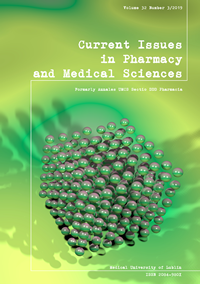Biochemical aspects of KB-28 compound on physically loaded study subjects
DOI:
https://doi.org/10.2478/cipms-2019-0030Słowa kluczowe:
acute lymphoblastic leukemia, physical endurance, carbohydrate metabolism, lipid metabolism, 2-ethylthiobenzimidazole hydrobromide, sodium 2-(tetrazolo[1,5-c] quinazoline-5-ylthio)acetateAbstrakt
In previous studies of actoprotective activity of 5-R-thio-tetrazolo[1,5]quinazoline derivatives in normal and complicated experimental conditions, sodium 2-(tetrazolo [1,5-c]quinazoline-5-ylthio)acetate (KB-28) was found to be the leader of the experiment. The objective of the current study was to characterize the effects of KB-28 compounds on carbohydrate and lipid exchange indices under the conditions of physical load as a possible mechanism of actoprotective effect. In the course of the experiment, the indices of carbohydrate and lipid exchange in the muscle, blood and liver of animal models were determined following a 15-day physical load course. In doing so, glucose, glycogen and total lipid concentrations were assessed. The KB-28 compound was administered daily at levels determined during the course of regular physical load normalized metabolic processes in rats. The results were then compared to a control which received intraperitoneally the equivolume 0.9% sodium chloride solution. The phenomenon of actoprotection consisted in enhancing concentrations of glycogen in skeletal muscles and liver. Compared to the control figures, this increase was 28.8% and 25.0%, accordingly. Moreover, the course of KB-28 caused a statistically significant reduction (by 32.1%) of the total serum lipid concentration in the animals under physical load. The effect may be a sign of the ability of this substance to utilize active lipolysis for improvement of the skeletal muscle performance. Having analyzed the results obtained, we can draw a conclusion that influencing the biochemical processes in the study models is one of the mechanisms of the KB-28 actoprotective effect.
Bibliografia
1. Gratas-Delamarche A, Derbre F, Vincent S, Cillard J. Physical inactivity, insulin resistance, and the oxidative-inflammatory loop. Free Rad Res. 2014;1:93-108.
2. Nikolaidis MG, Kyparos A, Spanou C, Paschalis V, Theodorou AA, Vrabas IS. Redox biology of exercise: an integrative and comparative consideration of some overlooked issues. J Exp Biol. 2012;215(10):1615-25.
3. Rauch HG, Schonbachler G, Noakes TD. Neural correlates of motor vigour and motor urgency during exercise. Sports Med. 2013;43:227-241.
4. Wilmor JH, Costill DI. Physiology of sport and exercise. Illinois: Human Kinetics; 2004:726
5. Lukyanchuk VD, Simonova IV. Actoprotectors: pharmacology and pharmacotherapy. Pharmacol Med Toxicol. 2015;2:14-26
6. Oliynyk S, Oh S. The Pharmacology of Actoprotectors: Practical Application for Improvement of Mental and Physical Performance. Biomols Ther. 2012;20(5):446-56.
7. Kolomoets OS, Nosulenko IS, Voskoboynik ОY, Berest GG, Kovalenko SI, Trzhetsinsky SD. Actoprotective activity of 6-monosub-stituted 3-R-6,7-dihydro-2H-[1,2,4]triazino-[2,3-c]quinazoline-2-ones. Curr Issues Pharm Med Sci Pract. 2016;3:59-66.
8. Kolomoets OS, Voskoboynik ОY, Nosulenko IS, Kryvoshey OV, Avramenko AI, Berest GG. 3’-R-spiro[cycloalkyl-1(2),(hetaryl-3 (4), 6’-[1,2,4]triazino[2,3-c]quinazoline]-2’(7’H)-2-оnes as a perspective class of compounds with actoprotective activity. Zaporozhye Med J. 2017;19:227-32.
9. Saienko A, Voloshchuk N, Toziuk O, Kryvoviaz O, Kryvoviaz S, Koval V. Assessment of MT-279 compound effect on physical endurance of rats under conditions of chronic hypokinesia. Current Issues in Pharmacy and Medical Sciences. 2017;3:134-7.
10. Stepanjuk GІ, Toziuk OYu, Kovalenko SІ, Chornoіvan NG, Antipenko LM, Antipenko OM, inventors; National Pirogov Memorial Medical University, Vinnytsya, assignee. 5-R-thiotetrazolo[1,5-c]quinazolines which increase the physical endurance. Ukraine Patent 79229. 2013 Apr 10; Bulleten 7
11. Toziuk O, Kryvoviaz O, Kryvoviaz S, Ivko T, Balicka O. Effect of 5-R-Thio-Tetrazolo[1,5-C]Quinazoline Derivatives on the Physical Performance in Different Types of Physical Exercise. Asian J Pharm. 2017;11(3)(Suppl):532-5.
12. Antypenko OM, Kovalenko SI, Karpenko OV. Synthesis and hydrolytic cleavage of tetrazolo[1,5-c]quinazolines. Synth Commun. 2016;46:551-5. http://doi.org/10.1080/00397911.2016.1156131
13. Toziuk O. Investigation of effect of sodium 2-(tetrazolquinazolin-5-iltio)-acetate (compound KB-28) on the metabolic processes in organism during intensive exercise. ScienceRise: Pharmaceutical Science. 2016;4:60-4. DOI
14. Toziuk O, Voloshchuk N, Germanyuk T, Kryvoviaz O, Kryvoviaz S, Ivko T et. al. Characteristics of 2-(tetrazol[1,5-c]quinazolin-5-ylthio) acetate effect on the level of adenine nucleotides in intense physical activity. International Journal of Green Pharmacy. 2017;4:276-80.
15. Contarteze RV, Manchado FB, Gobatto CA, De Mello MA. Stress biomarkers in rats submitted to swimming and treadmill running exercises. Comp Biochem Physiol A Mol Integr Physiol. 2008;151(3):415-22.
16. Hubner-Wozniak I, Kosmol A, Blachnio D. Anaerobic capacity of upper and lower limbs muscles in combat sports contestants. J Combat Sports and Martial. 2011;2(2):91-4.
17. Chamari K, Padulo J. ‘Aerobic’ and ‘Anaerobic’ terms used in exercise physiology: a critical terminology reflection. Sports Med Open. 2015;1(9):1-4.
18. Kits Van Heijningen AJ, Kemp A. Free and fixed glycogen in rat muscle. Biochem J. 1955;59:487-91
19. Selye H. 1974. Stress without Distress. Philadelphia: Lippincott.
20. Baker JS, McCormick MC, Robergs RA. Interaction among skeletal muscle metabolic energy systems during intense exercise. J Nutr Metab. 2010;Article ID 905612:2-13.
21. Eizadi M, Nazem F, Zarifyan A, Eghdami A, Khorshidi D. The Effect of Chronic Intake of L-carnitine L-tartrate on Lipid Metabolism during Aerobic Exercise. J Kerman U Med Sci. 2010;17(2):113-20
22. Ji LL, Zhang Y. Antioxidant and anti-inflammatory effects of exercise: role of redox signaling. Free Rad Res. 2013;48(1):3-11.
23. Pingitore A, Lima G, Mastorci F, Quinones A, Iervasi G, Vassalle C. Exercise and oxidative stress: Potential effects of antioxidant dietary strategies in sports. Nutrition. 2015;31(7-8):916-22.
Pobrania
Opublikowane
Numer
Dział
Licencja
Prawa autorskie (c) 2019 Autorzy

Praca jest udostępniana na licencji Creative Commons Attribution-NonCommercial-NoDerivatives 3.0 Unported License.


